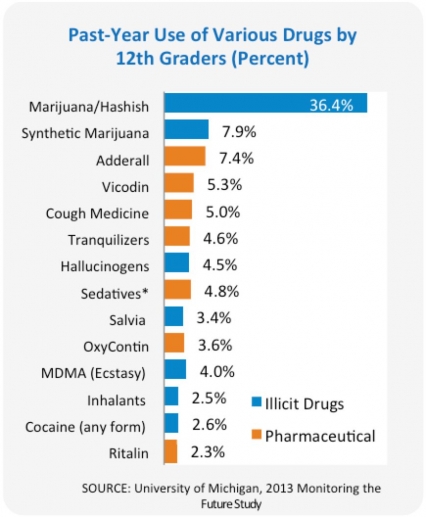
Every year, the Monitoring the Future (MTF) survey measures drug, alcohol, and tobacco use and related attitudes among 8th, 10th, and 12th graders. Following are facts and statistics about youth substance use from the 2013 MTF report
New synthetic drugs are a cause for concern, but their use is not increasing. Synthetic marijuana (also known as Spice or K2)—referring to herbal mixtures laced with synthetic chemicals similar to THC, the main active ingredient in marijuana—was added to the MTF survey in 2011, when 11.4 percent of high school seniors reported using it in the past year; in 2013, it had dropped to 7.9 percent. These mixtures could be obtained legally until 2012 and are still wrongly perceived as a safe alternative to marijuana. The synthetic stimulants known as “bath salts” were added to the survey in 2012; in 2013, just 0.9 percent of seniors had used these drugs in the past year.
Nonmedical use of prescription and over-the-counter medicines remains a significant part of the teen drug problem. In 2013, 15.0 percent of high school seniors used a prescription drug non-medically in the past year. The survey shows continued abuse of Adderall, commonly used to treat attention deficit hyperactivity disorder, or ADHD, with 7.4 percent of seniors reporting taking it for non-medical reasons in the past year. However, only 2.3 percent of seniors report abuse of Ritalin, another ADHD medication. Abuse of the opioid pain reliever Vicodin has shown a marked decrease in the last 10 years, now measured at 5.3 percent for high school seniors, compared to 10.5 percent in 2003. In addition, 5 percent of seniors report abuse of cough products containing dextromethorphan, down from 6.9 percent in 2006, the first year it was measured by the survey.
Courtesy National Institute on Drug Abuse, National Institute of Health
Other Related Articles
- How Does Addiction Take Hold in the Brain?
- Drugs Of Abuse Target The Brain’s Pleasure Center
- Brain and Heart Metabolism
- The Neurobiology of Drug Addiction
- Addiction is similar to other chronic diseases. Like heart disease, drug addiction can be prevented and treated successfully. If left untreated, however, its effects can last a lifetime.
- Drug Usage Among Teenager remains high, largely due to increasing popularity of marijuana
- Positive trends in the past several years include reduced use of inhalants and less use of cocaine, especially crack cocaine.
- Fewer teens smoke cigarettes than smoke marijuana.
- Other forms of smoked tobacco are becoming popular, however



